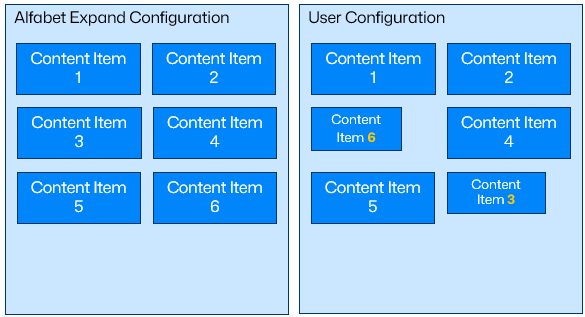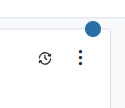Define content area adaptability by users
When designing a content area, you should take the ability of the user to change the content area into account.
With default edit capabilities for a content area, the user can change the content area design provided by you in Alfabet Expand.
Users can:
- hide content pages and later add them again,
- create new content pages and add them to the content repository,
- re-size, move and hide content items,
- add content items available in the content repository,
- add indicator cards added to the content repository by an administrative user,
- add own visualizations from a data workbench to the content repository,
- add views which they have access to the content repository.
As a result, the content area available to each user might differ considerably from the default configuration of the content area that you provide to the user via Alfabet Expand.
You have configured a content area page with six content items in a specific order. A user re-designed the page. The user re-sized and moved content item 3 and added content item 6 at the position content item 3 was located in the initial configuration:

When the user changes the content area, the user configuration is stored for the user. When the user comes back to the content area, the stored user configuration is used instead of the original Alfabet Expand configuration to render the content area.
When you change the content area configuration in Alfabet Expand later, these changes will be merged into the changes made by the users in the following way:
- Changes of size and position of a content item are not changing the user configuration.
- If you change the setting of a content item, the content item in the user configuration will be updated accordingly, no matter which position it has been moved to. For example, changing the background color of a content item in Alfabet Expand will change the background color in the user configuration.
- If you remove a content item, the content item will be removed from the user configuration of the content area.
- If you add content items, these content items are added to the user configuration at the bottom of the content page, no matter which position they have in your configuration. They are marked with a blue dot to inform the user that they are new.

In the setting of the example above, the solution designer now changes the content area content in Alfabet Expand. Content item 5 is now removed from the configuration and content item 7 and 8 are added. In addition, a setting is changed for the existing content item 1A.
As a result, the user will see a changed content item 1A and content item 5 is removed. The new content items 7 and 8 are added to the content area. The change in position and size of content item 6 and 3 that the user configured is still applied.

As a solution designer, you can pre-define the content repository content and decide to which extend users can alter a content page.
While your workbench configuration shows all content items all users shall have immediate access to, you can additionally configure optional content which is not added to a content page, but available to the users in the content repository of the content area. By default users can add these content items any time to any of the existing content pages or new content pages the user creates. Optionally you can limit availability to a single content area or even to a single content page in a specific content area.
If you do not provide a content repository, users can still add their own content items to the content repository. Content items which are added to the content area configuration are automatically part of the content repository. Users can hide these views and restore them later.
In your content area configuration, you can add content items that shall be added to the content repository in the same way as visible content items and set the Default Visibility attribute to hidden.
Alternatively, you can define the content repository content in the class settings. You can define a different content repository for different user profiles via the class settings.
You can start your content area definition with the definition of a content repository, adding all content items including the content items that shall be directly visible in the default configuration of the content area. You can then use the functionality for designing the layout of the content area in the web-based content area designer to define all content page content from the content repository.
- In Alfabet Expand, go to the Presentations tab.
- Expand the node of the relevant class settings under the Class Settings node. For class-based content area, use the class settings of the respective object class. For class-independent content areas, use class settings defined for ALFA_GLOBAL_.
- For each configuration element you would like to add to the default content repository, right-click the System Content Repository node and select the option for adding the type of configuration element you would like to add. In the selector, select the configuration element and click OK.
- In the attribute window, you can optionally limit the availability or change the caption of the content item:
- Caption: Enter a caption that shall be displayed instead of the caption of the content in the content item.
- Target Content Area: Select a content area from the drop-down list to limit availability of the content item to the content repository of the selected content area.
- Target Content Page: Select a content page in the content area specified with the Target Content Area attribute to limit availability of the content item to the content repository of the selected content page.
You can restrict the ability of the user to alter the content of a content area. The options for setting user permissions to alter the content area can be defined on various levels of the configuration:
- In the attributes of the user profile. The settings in the user profile apply to all content areas in the user profile. Settings in the class settings or in the content area definition will be overwritten.
- In the content area modification of the class settings. Modifications in the class settings apply to the modified content area only in the user profiles the class settings are assigned to. Settings in the content area definition will be overwritten.
- In the attributes of the content area page. Modifications are applied to the content area in all user profiles if not otherwise specified in the user profile.
The settings in a user profile supersede the settings in class settings. The settings done in class settings supersede the settings directly in the content area page. If you want to disable button functionality on the class settings level for class-independent content areas, you must specify the settings in the ALFA_GLOBAL_CLASS_SETTINGS.
Restriction of user editability will disable the respective buttons in the three-dots menu of the data workbench.
The table gives an overview of the functionality which can be disabled and where you can disable it:
| Restriction | Effect | can be set for content area page | can be set in class settings | can be set in user profile |
|---|---|---|---|---|
| Disable moving of content items | Users will not be able to change the default layout of the default content items on the content pages. Content items can neither be moved nor re-sized. | yes | no | yes |
| Disable the content area button for adding and hiding content. | Users will not be able to manage content on page. This includes hiding and adding content items and adding own content to content areas. The Manage Content on Page button is hidden from the three-dots menu of the content area. The user can still hide menu items via the Hide button in the menu of the content items unless it is also disabled. | no | yes | yes |
| Disable hiding of content items in the content item menu | Users will not be able to hide content items via the Hide button from the three-dots menu of content items. Users can still hide menu items via the Manage Content on Page functionality unless it is also disabled. | no | yes | yes |
| Disable the ability of the user to add own content pages. | Disable the ability of the user to change content pages in a content area. The Show/Hide Page Button and the Add New Page button will be hidden from the three-dots menu of content areas. The Add Current Page to Content Repository, Edit Page Details, and Delete Page buttons will be disabled. | no | yes | yes |